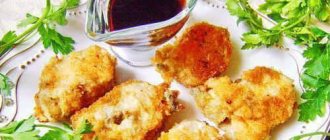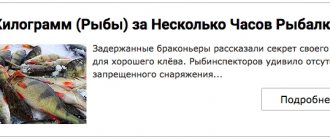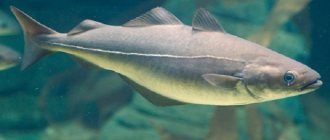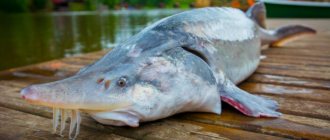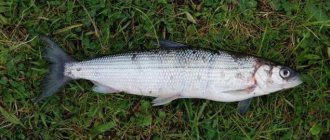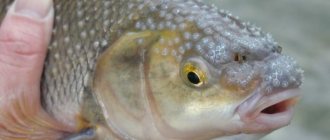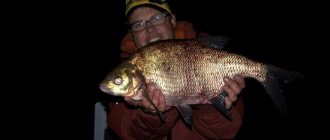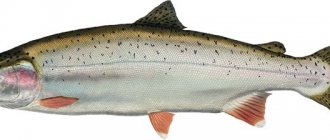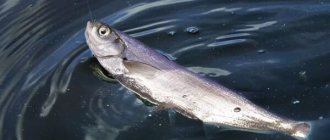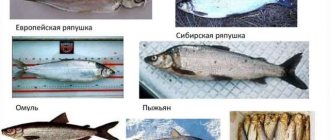Pollock is a cold-loving fish of the cod family that lives in bottom-pelagic layers of water. Its greatest distribution is recorded in the North Pacific region.
Which fish tastes better?
- Cod 49%, 1237 votes
1237 votes 49%1237 votes - 49% of all votes
- Pollock 27%, 685 votes
685 votes 27%
685 votes - 27% of all votes
- Heck 23%, 581 votes
581 votes 23%
581 votes - 23% of all votes
Total votes: 2503
04.12.2019
Characteristics of pollock
This fish chooses cold water to live (up to a maximum of 10 degrees) and during the daytime goes to a depth of up to 300 meters. These two points are partly related. At night, the fish prefers to stay in the middle or upper layers of water. Because of this, the pollock fish is characterized as pelagic (that is, it lives in the corresponding pelagic water columns). Since it is not bottom (deep-sea), this determines the ease of catching and what the fish looks like.
Pollock can descend to a depth of five thousand meters or more, traveling to spawning grounds. The life cycle is long and is about 15 years. Spawning forces pollock to move into shallow water, so during this time period large concentrations of spawning fish can be observed directly off the coast (50 meters from the coastline).
Reproduction
Young pollock reaches sexual maturity at 3 or 4 years of age. By this time, he is already gaining his maximum mass, which is unlikely to change. It usually ranges from 2.5 to 5 kilograms, depending on the habitat of the fish. Since pollock lives for about 16 years, one individual spawns approximately 11–12 times. Pollock swims to the shores in very dense schools, mainly in shallow water, where the depth is only 50–100 meters.
Pollock spawns at different times of the year. Any coast of the Pacific Ocean becomes spawning grounds. In the Bering Sea, the spawning period occurs in spring and summer: spawning occurs from March to early September. In the southern parts of the Pacific Ocean, pollock spawns exclusively in winter and spring. In this case, spawning begins at the end of November, and the spawning period ends in March. In Kamchatka, spawning occurs only in spring.
The eggs released from the body are suspended in the water column. It usually swims at a depth of about 50 meters. A distinctive feature is that pollock can reproduce at subzero temperatures of –2…–1 degrees Celsius. This is possible due to the fact that salt water freezes under more severe temperature conditions, and pollock does not freeze due to the natural antifreeze contained in the blood.
Industrial pollock fishing
Fish is caught on an industrial scale using fixed nets and trawls. Its meat is valued for its low fat content, high taste, low bone content and high protein content. The photo above shows a photo of a pollock dish: it looks delicious!
Appearance
The length of the body reaches 90 cm, and the weight increases throughout life to 5 kg. It has an elongated body shape, which is typical for most fish species. The narrowing is fixed in the direction from head to tail. The body covering consists of silvery scales.
Distinctive features of this type of fish:
- there are 3 fins on the back: the first is closer to the head of medium size, then the most elevated and large;
- specificity of the lower fins: the abdominal ones are located in front of the pectoral ones;
- a small antennae grows under the lower jaw;
- darkened back and spots all over the body, as well as a marsh green tint on the sides;
- disproportionately large head and eyes, which can be seen in numerous photographs;
- the lower jaw protrudes forward in relation to the upper.
Sexual maturation of individuals reaches its peak after 3-4 years of life. During this period, maximum body weight is gained. In the standard, it can reflect different indicators depending on the habitat. More specifically, vary in the following range: 2.5-5 kilograms.
Appearance and features
Photo: What pollock looks like
We've figured out the dimensions of the fish, let's move on to considering its shape. The entire figure of pollock is elongated and greatly narrows closer to the tail. The scales on the body are small and silvery; in the ridge area their color is noticeably darker. Pollock is characterized by a pattern in the form of small dark brown spots, which are scattered over the body and head and are located precisely in the upper part of the fish, which is colored darker than the light, whitish belly.
The head of the fish looks quite large relative to its body; it has very large fish eyes. A distinctive feature of pollock is a small mustache located under the lower lip of the fish; it performs a tactile function, because this fish is deep-sea. It is worth noting that the jaw apparatus of the fish protrudes slightly forward on the lower side.
Pollock has three dorsal and two anal fins, which are separated by small gaps. Three separate fins rise on the ridge of the fish, the first is very close to the head area, the second is distinguished by the largest dimensions and length, the third is closer to the tail area. Pollock also has fins located on the belly, which are located in front of the pectorals. The lateral fish line is characterized by rather sharp bends.
Diet
In terms of what pollock eats, it can be compared with mackerel, cod, tuna and horse mackerel (“related” fish species). He finds food for himself at several levels of the food chain, not far from each other. Changes in diet are especially evident as individuals grow older.
What to eat at the beginning of life:
- plankton (small crustaceans);
- amphipods;
- krill;
- nematodes.
Then, as they grow, larger prey is added to the diet, which the individuals hunt on their own. Most often these are squid and small fish.
Predator or not
Pelagic fish species are mostly predators. This is confirmed by the above facts about pollock eating other living organisms. Pollock, like all inhabitants of the aquatic world, occupies an important ecological niche in the waters of the world's oceans and individual seas.
It manifests itself when it consumes larvae and fry of its own species (not adults). The fish in question can happily feed on eggs and hatched fry of other fish species. Large fish of other species are not included in the pollock diet.
Are there many bones in pollock?
Naturally, pollock has a large ridge along the body and bones extending from the sides. Small bones are not found in other parts of the carcass. Therefore, the fish is not bony.
The side bones are easily pulled out for later eating of the fish. But provided that the fish is of good quality, that is, it is not small-sized young fish and not frozen during storage.
When purchasing cut fillets rather than whole headless carcasses, during verification they may also contain a small number of individual bones. This aspect depends on the specific manufacturer. That is, on the specifics of the supplies of fish products purchased by him and the method of production of the semi-finished product. According to organoleptic indicators, this is a disadvantage for pollock.
Bone pollock fillet – a myth
The most common defect due to which some brands of pollock have failed in organoleptic tests is the presence of bones in the fish. However, in most of the studied pollock, single bones were found only in individual fillet layers. And only in pollock of one brand – Fish
House
– we found vertebral and large rib bones. Thus, we managed to debunk the myth that pollock fillet is bony. Eat calmly.
Be the first to know about new materials from Roskachestvo, subscribe to our newsletter !
Where does it live in Russia?
Trademarks produce their products in different regions of the country: Kamchatka, Murmansk region, Yuzhno-Sakhalinsk, Moscow and Moscow region, Ryazan, Kaluga regions, etc. But this does not mean that pollock is found everywhere. Supplies are made from a limited number of locations. Domestic pollock or pollock caught in China ends up on store shelves (we remind you that this country borders Russia, which is why supplies from here are financially profitable). But Chinese manufacturers can artificially increase the water composition of the carcass, thus increasing the mass of the frozen product. Therefore, domestic catch remains prerogative.
Pollock where it lives and lives near the Russian Federation:
- Barencevo sea;
- Bering Sea;
- Japanese Sea.
Aquaculture (when fish is sold through artificial cultivation) is not relevant for pollock. This activity is more justified for salmon and more expensive varieties of fish. Pollock (unlike even salmon, and even more so eel, sturgeon, etc.) is a cheaper fish that is easier to catch on a large scale in the natural environment.
Where does pollock live?
Photo: Pollock in Russia
Pollock is a widespread fish. It has taken a fancy to the North Atlantic, occurring in its western and eastern parts. In the west, the fish habitat extends from the Hudson Strait to Cape Hatteras, located in North Carolina. In the eastern North Atlantic, the fish spread from Spitsbergen to the Bay of Biscay.
Pollock also lives in the waters of the Barents Sea near Iceland. In the northeast Atlantic, pollock can be found in the coastal zone of the Norwegian state, near the Faroe Islands; its distribution area reaches the aforementioned Bay of Biscay and the coasts of Ireland and England.
As for the Asian coast, pollock inhabits the Sea of Okhotsk, Bering and Japan.
On the American coast, fish are stationed in the following waters:
- Bering Sea;
- Monterey Bay;
- Gulf of Alaska.
It should be added that it is practically impossible to find pollock in ocean waters south of the Sangar Strait, which connects the waters of the Sea of Japan with the Pacific Ocean. Only occasionally single individuals are found there; it is not for nothing that this fish is considered cold-loving, because it prefers cool, icy waters. In general, pollock is called a bottom-pelagic fish, i.e. fish that live in the aquatic zone, which is not in close proximity to the bottom surface.
Now you know where pollock is found. Let's see what he eats.
River or sea
Important information for determining whether a fish is bony or not is the place in which it lives. That is, whether the fish is sea or freshwater river. Pollock is not characterized as a river variety and belongs to the first type. This means it has fewer bones (especially small ones in the pulp itself). But to be extremely precise, the habitat of pollock is most likely in oceanic waters. Therefore, pollock is categorized as either Pacific or Atlantic. Since the seas flow into the oceans, schools of pollock eventually spread by geolocation and constantly live in the sea area. The main parameters of the waters in which this fish lives are salinity and temperature. Pollock is found where it does not exceed 10 degrees, and the habitat is not freshwater.
Greek fish
Welcome to our Greek fish photo market! This article is all about Greek fish. Fish in Greek is "psAri", in the plural - "psArya". Fish in Greece is one of its attractions. You won’t deny that one of the mandatory items in a holiday program in Greece is a trip to Greek taverns to eat freshly prepared fish. However, in taverns in Greece you will most likely be offered a menu in Russian, but only in large resorts. But in traditional Greek villages or in a fish shop (ichthyopolio) there will be no translator! Therefore, you need to master this serious and voluminous topic even before arriving in Greece. We offer our assistance in studying the diversity of the Greek fish menu and varieties of Greek fish. This article is dedicated to fish, and the next one will be about Greek seafood.
So, here are photos and brief descriptions of the fish , as they look at the traditional street market, which is called Laiki (from the word “Laos” - people).
Gopa is a minke whale. Classic-looking fish, white belly, light gray back, no special features. A simple-looking fish, although it belongs to the order of sea crucians.
Xiphias is a swordfish. Often in taverns they cook shish kebab from it, the meat is reddish in color. A very common fish in both markets and taverns.
Perca is a perch family. The price tags show prices for 1 kg of fish in euros. The price of fish in Greece is not low, as elsewhere in the Mediterranean. However, the price varies depending on where the fish was grown. If it was caught at sea, it will be more expensive. Artificially grown will be cheaper, sometimes 2 times.
Faggria (fangri) - sea bream. Carp family. Almost half of all existing fish, it turns out, belong to this group. The Greeks serve any fish with a lemon cut into two halves. It is customary to pour lemon juice on fish before eating. Try it, you will like it.
Sargos is a white bream, about 20 cm in size.
Two words about the Greek fish soup, which is called “psarOsupa”. Don't expect her to look like Russian. The main difference is that lemon juice is added to Greek fish soup.
Solomos - salmon. Salmon is delivered to Greece from Scandinavia.
Kutsomura, also known as Barbuni, is a fish with a blunt nose, white and pink in color, and can be large, medium or small, varying in size and price. Very tasty and filling fish. Weekend fish for the Greeks. 5-6 pieces are enough for one human female to eat.
Tsipura - Dorado or sea bass. Tender white fish, prepared in different ways, you can simply bake it in the oven. Very popular among both Greeks and foreigners, quite expensive. Artificially grown is 2 times cheaper. For one adult man, one sea bream plus a salad is usually enough to feel full, and the second fish is usually enough for the wife and child to eat.
Galeos is a soup shark; as a rule, it is sold already cut into portions, the meat is white. This shark is found in Greece. Naturally, it is not dangerous to humans; in general, there are no dangerous sharks in the Greek seas.
BakalYaros belongs to the order of cod fish, but is much larger than the usual cod or hake. Small bacalyaros are called diminutively Bakalyaraki. Popular and relatively inexpensive.
Aferina is a small fish, but it can still be small or medium-small and varies in price. It tastes similar to smelt, is very filling, can be eaten whole, as it practically has no bones. A portion in a tavern costs 7 - 8 euros.
Marida is a small fish, but there are also medium-sized specimens, quite dense to the touch, suitable for frying.
Gavros is practically sprat. For some reason it is also called anchovy. If you hold it in brine from sprat, you get the same taste. This fish is frying, cheap and popular. The market price is 3-4 euros per kg.
Sardella is the same as sardine, a small inexpensive fish, it is very suitable for being cooked over coals, it becomes quite tasty. Not to be confused with sausages! This meat product is called completely differently in Greece.
Lavrak is a sea pike perch. In Russian restaurants it is also called sea-bass. It costs about 10 euros per kg on the market; as a rule, they sell artificially grown fish; wild fish is quite rare, larger in size and much more expensive.
Kolios is a relative of Mackerel and is a small fish.
Milokopi is a medium-sized fish, sprat-colored, tasty.
Tonos - tuna. For some reason, you don’t often see it on the market. Maybe because there is a lot of cooked tuna in all stores.
Lakerda is a family of tuna fish. It is often served pickled in taverns as an appetizer (appetizer). The Greek word for appetizers is mezEdes. Don't deny yourself the pleasure of ordering a couple while you wait for the fish to cook.
Kefalos is a mullet.
Bon appetit!
Why is it sold without a head?
An important aspect for answering the question posed here is the frequent detection of helminths in the head area of fish. And also the overall usefulness of the product is questioned when selling a full carcass along with the head.
Pollock can indeed have worm-like parasites in its body. The favorite place for parasites is the space behind the gills, but many species of other fish suffer from this problem, not just pollock.
The main point is still the overall value of the whole fish carcass. Previously, in the Soviet Union, pollock fish was not considered valuable or edible. It was mined on a large scale, but for the production of animal feed. That is, it went towards the development of agriculture and ensured the production of food for pets (to a lesser extent). Because of this, its population began to decline sharply, and pollock was transferred to the category of valuable species. At the same time, it entered the diet of residents of the fraternal Soviet countries. Its production has decreased. But it can be said affirmatively that it makes up the majority of the world's fisheries. Its production is very simple (since pollock fish lives in the upper layers of water) and inexpensive. Therefore, the value of the carcass completely disappears. Usually, buyers' heads and entrails go to waste anyway. And for the production of feed, all this is still valuable. Therefore, they are used for production purposes, and carcasses without heads and without tripe enter the consumer market.
The assumption that the fish has an unsightly head and this may aesthetically discourage the buyer from purchasing it is not entirely tenable. You can verify this by looking at a photo of pollock.
Pollock: description, preparation, composition, benefits and harm
Pollock (lat. Theragra chalcogramma) is a very common fish belonging to the Cod family. The largest populations of pollock are found in the North Pacific Ocean. Pollock, together with blue whiting, was not considered a serious food resource just a few decades ago. However, with the depletion of stocks of other fish species, the volume of catch of these two named species is increasing every year, amounting to about 3,200 thousand tons on a global scale in 2015, and the Russian catch in the same year amounted to 1,652 thousand tons. As you can see, half of the world's pollock production is caught by Russian fishermen. The leading places in pollock production are also occupied by Germany, France and the UK.
Pollock now ranks first in the world in terms of production among all other fish. Pollock is caught mainly by trawls and fixed seines. The size of the catch is highly dependent on the size of the pollock population in the ocean, which can vary quite widely from year to year, as well as from the fishing season. Currently, pollock stocks have begun to decline sharply due to overfishing, which has led to calls from Greenpeace since 2009 to refrain from purchasing and consuming this fish and its products.
A close relative of this fish is the Atlantic pollock (lat. Theragra finnmarchica) discovered in the Barents Sea, which, due to limited stocks, is of no commercial value.
Description of pollock
Pollock is a medium-sized fish. The maximum length reaches 90 cm with a weight of almost 4 kg.
Pollock lives up to 15 years.
There are three fins on the back. Characteristic features of the fish are also the presence of a very short barbel on the chin, the location of the pelvic fins in front of the pectoral fins, spotted coloring and large eyes.
Pollock lifestyle
Pollock lives in cold waters (with a temperature of 2-9 o C), preferring to stay at depths of 200-300 m (pelagic fish). It often makes vertical migrations, descending to depths of 500-700 m and even deeper.
Puberty occurs at 3-4 years. By this age, the fish reaches its maximum weight and hardly grows any further.
During the spawning period, it approaches the shores and stays at depths of 50-100 m, forming very dense aggregations. Spawning can take place at different times of the year: in the Bering Sea from March to October, off the coast of the Korean Peninsula from November to March, off the coast of Kamchatka in the spring. The water temperature affects this; females can spawn even at a sea water temperature of -1.8 o C. The eggs are pelagic.
The diet of young pollock includes small crustaceans (plankton), then, as they grow older, pollock switches to feeding on small fish (capelin, smelt) and squid. Cannibalism (eating one's own larvae and fry) is a very common phenomenon among pollock.
Pollock in cooking
If you are not a resident of the Pacific Coast or even just the Far East, you are unlikely to be able to buy fresh pollock in the store. It is usually sold frozen, either whole or as fillets.
Among pollock products in retail chains you can also find salted caviar and pollock liver. The main filler of the so-called “crab sticks” and “crab meat” is pollock (fillet). Surimi is from the same series.
Beer lovers should be well aware of the now widely sold “amber fish with pepper.” This is dried pollock.
Countless dishes can be prepared from pollock. The fish meat is dry and dietary, which should be taken into account when preparing pollock. So, if you decide to bake it, it is best to do it with vegetables (tomatoes, peppers, carrots, onions) and in foil, otherwise it will turn out dry. If you decide to fry fish, then after shallow frying it is advisable to close the pan with a lid and simmer the fish in this way.
Pollock soup will be very healthy and tasty, in which, for variety, you can put several pieces of fattier fish (halibut, salmon, etc.).
Pollock is a very popular fish, the taste of which is known to many citizens since childhood. Back in Soviet times, there were so-called fish days, when workers and employees in canteens were offered pollock on Tuesdays and Thursdays. The size of the pollock population is simply huge, so the fish is widespread throughout the world, including in North America. The famous McDonald's uses fillets of this fish to prepare breaded fish sticks, as well as to prepare a host of other fish dishes.
Is it possible to eat the head
Parasitic worms are found inside various representatives of the animal world and humans (ascaris and pinworms are common in the human population). Therefore, their presence in fish is not something shocking. The life cycle of such worms involves the transition from one host to another in the form of eggs, larvae or adults. They can enter the body when they are present in unprocessed food. Therefore, consuming raw fish is dangerous to health. After all, worms can settle not only inside the head.
During heat treatment, the danger to humans is reduced to zero. But this is an additional point for refusing to sell carcasses together with the head. Fundamentally, this by-product has no nutritional value for consumers themselves, because the fish is cheap.
Chemical composition and KBZHU
Pollock contains:
- valuable acids: polyunsaturated (arachidonic, omega-3, linoleic), saturated (stearic, myristic, palmitic), monounsaturated (oleic, palmitoleic);
- vitamins: A, C, Retinol, PP, B1 and B2, as well as B6 and B9;
- microelements: calcium, phosphorus, magnesium, sodium, potassium, etc.;
- trace elements: zinc, iron, iodine, fluorine, etc.
Pollock is a leader in the level of beneficial selenium, iodine, and protein. It also has low histamine levels, which is a positive feature.
Nutritional value per 100 g:
- fats - 0.9 grams;
- proteins - 15.9 grams;
- cholesterol - 50 milligrams;
This fish has no calories. There are approximately 70 kcal per 100 grams of product. Thanks to this, pollock can be considered dietary. But when frying, the calorie content increases due to the oil used.
Selection and storage
Pollock is often supplied to stores frozen. When choosing it, you need to pay attention to certain parameters. First, what the fish looks like. The surface of the carcass should have a light and uniform shade. The presence of stripes and extra inclusions of yellow or green color (not spots of natural origin in the color of the fish) indicates that the carcass was thawed and frozen again. The presence of snow and ice indicates improper storage with a possible loss of the taste of the fish during its preparation. According to GOST, frozen specimens must be stored at a temperature not lower than -18 degrees. This is the only way the fish retains its taste and beneficial properties.
When choosing by manufacturers, keep in mind that the Far Eastern ones are more often than others characterized by the high quality of their product. Russian manufacturers sell a cheaper product, so it is popular as an export.
“After purchasing fish and for its further preparation, you need to defrost it correctly. It is better to do this in a gentle mode, that is, move the carcasses from the freezer to the main cooling chamber. Otherwise, the fish dish becomes tasteless.”
Properties
General useful qualities:
- strengthening the immune system thanks to the beneficial substances and vitamins contained here;
- maintaining the functioning of all vital systems of the body (increased zinc and iodine content ensures the normal functioning of the reproductive system and other properties);
- strengthening teeth and bones;
- reducing blood cholesterol and reducing the risk of developing atherosclerosis (when switching to proper nutrition including pollock);
- also increasing the elasticity of vascular walls;
- improving skin quality;
- etc.
Fish contains many useful substances, which is why its consumption is recommended for children and adults.
Negative properties are extremely difficult to identify. For example, an allergy to seafood is acceptable. But pollock in this regard can be called a non-allergenic product.
Useful properties of pollock
It is difficult to overestimate the usefulness of pollock for our body. Regular consumption of this fish reduces the risk of diseases of the cardiovascular system and reduces the risk of cancer.
The high iodine content helps prevent thyroid diseases, and therefore pediatricians recommend introducing pollock meat into baby food as early as eight months of age.
Pregnant and nursing mothers, as well as all those who have thyroid diseases, should not refuse a piece of pollock.
Pollock meat also has a beneficial effect on heavy smokers. Vitamin A reduces the risk of lung cancer. Pollock helps control blood cholesterol levels and improves brain activity.
The low calorie content of pollock allows this product to be included in the diet of obese people. Pollock meat helps increase metabolism and improves the functioning of the gastrointestinal tract.
Fishing
If we take cod species into account, pollock occupies a leading place among them in terms of catch volume. To a greater extent, this volume also depends on the place of production, the fertility of the pollock generation and seasonality.
It should be noted that in the 90s. its production was estimated at about five million tons per year. Since this caused the threat of extinction of the species, many countries reduced its production several times.
For Russia, the production of this species in volume is almost half of the total fishing volume.
